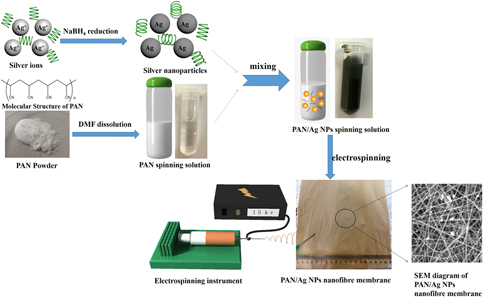Crossref Citations
This article has been cited by the following publications. This list is generated based on data provided by
Crossref.
Arman Kandirmaz, Emine
and
Ozcan, Arif
2019.
Antibacterial effect of Ag nanoparticles into the paper coatings.
Nordic Pulp & Paper Research Journal,
Vol. 34,
Issue. 4,
p.
507.
Chen, Yixiang
Wang, Zehong
Xu, Rui
Wang, Wei
and
Yu, Dan
2020.
A highly sensitive and wearable pressure sensor based on conductive polyacrylonitrile nanofibrous membrane via electroless silver plating.
Chemical Engineering Journal,
Vol. 394,
Issue. ,
p.
124960.
Park, Kyuhyun
Kang, Sangmo
Park, Ji-woon
and
Hwang, Jungho
2021.
Fabrication of silver nanowire coated fibrous air filter medium via a two-step process of electrospinning and electrospray for anti-bioaerosol treatment.
Journal of Hazardous Materials,
Vol. 411,
Issue. ,
p.
125043.
Qin, Yajie
Zhang, Qi
Pan, Wei
Zhang, Jintao
Wang, Zebo
Qi, Yu
and
Yu, Hongqin
2022.
Dyeable PAN/CuS Nanofiber Membranes with Excellent Mechanical and Photothermal Conversion Properties via Electrospinning.
ACS Applied Polymer Materials,
Vol. 4,
Issue. 12,
p.
9144.
Tan, Pengfei
Jiang, Yuanzhang
Gong, Dakai
Shi, Yidong
Shi, Xianning
Wu, Pengfei
and
Tan, Lin
2022.
Synthetic polyurethane nanofibrous membrane with sustained rechargeability for integrated air cleaning.
Polymer,
Vol. 258,
Issue. ,
p.
125279.
Wang, Bin
Wang, Jie
Lou, Yaoyuan
Ding, Shanshan
Jin, Xu
Liu, Fang
Xu, Zhijun
Ma, Jiayu
Sun, Zhiming
and
Li, Xiuyan
2022.
Halloysite nanotubes strengthened electrospinning composite nanofiber membrane for on-skin flexible pressure sensor with high sensitivity, good breathability, and round-the-clock antibacterial activity.
Applied Clay Science,
Vol. 228,
Issue. ,
p.
106650.
Ren, Guomei
Wan, Keming
Kong, Hao
Guo, Lei
Wang, Yan
Liu, Xiaomin
and
Wei, Gang
2023.
Recent advance in biomass membranes: Fabrication, functional regulation, and antimicrobial applications.
Carbohydrate Polymers,
Vol. 305,
Issue. ,
p.
120537.
Hernández‐Orozco, María Mónica
Castellanos‐Espinoza, Raúl
Hernández‐Santos, Nuri Aranzazú
Ramírez‐Montiel, Fátima Berenice
Álvarez‐Contreras, Lorena
Arellano‐Arreola, Víctor Manuel
Padilla‐Vaca, Felipe
Arjona, Noé
and
España‐Sánchez, Beatriz Liliana
2023.
Antibacterial and electrochemical evaluation of electrospun polyethersulfone/silver composites as highly persistent nanomaterials.
Polymer Composites,
Vol. 44,
Issue. 3,
p.
1711.
Jensen, Madeline G.
O'Shaughnessy, Patrick T.
Shaffer, Marlee
Yu, Sooyoun
Choi, Yun Young
Christiansen, Megan
Stanier, Charles O.
Hartley, Michael
Huddle, Joey
Johnson, Jed
Bibby, Kyle
Myung, Nosang V.
and
Cwiertny, David M.
2023.
Simple fabrication of an electrospun polystyrene microfiber filter that meetsN95filtering facepiece respirator filtration and breathability standards.
Journal of Applied Polymer Science,
Vol. 140,
Issue. 5,
Farooq, Muhammad
Bilal, Muhammad Imran
Gohar, Sabeen
Khalid, Maira
Haider, Md. Kaiser
and
Kim, Ick Soo
2023.
Antibacterial Activity of Molybdenum Oxide–Polyacrylonitrile Composite Membrane with Fast Silver Ion Reduction.
ACS Omega,
Vol. 8,
Issue. 51,
p.
49467.
Lin, Sung-Ta
Hanh, Nguyen The Duc
Ooi, Chien Wei
Thew, Xue Er Crystal
Liu, Bing-Lan
Chiu, Chen‑Yaw
Lee, Hung-Che
Chen, Kuei-Hsiang
and
Chang, Yu-Kaung
2024.
Removal of protein wastes by amidoximated polyacrylonitrile nanofiber membrane decorated with dye wastes in batch and flow modes.
Biochemical Engineering Journal,
Vol. 201,
Issue. ,
p.
109119.
Amiri, Elahe
Khakbiz, Mehrdad
Bakhshandeh, Behnaz
Ranjbar, Nika
and
Mohammadnejad, Javad
2024.
Enhancing osteogenic differentiation of mesenchymal stem cells seeded on a polycaprolactone/MoS2 nanofibrous scaffold through electrical stimulation.
Molecular Systems Design & Engineering,
Vol. 9,
Issue. 6,
p.
581.
Taha, AmanyE.
Mowafi, Salwa
and
Hamouda, Asmaa S.
2024.
Hyperbranched polymeric membranes for industrial water purification.
Heliyon,
Vol. 10,
Issue. 11,
p.
e31318.
Javanifar, Roshan
Dabagh, Shadab
Kaya, Murat
Butun Sengel, Sultan
Ebrahimi, Aliakbar
Ghorbanpoor, Hamed
and
Avci, Huseyin
2025.
A novel green Microfiltration approach by developing a Lab-on-a-Chip System: A case study for Escherichia coli.
Separation and Purification Technology,
Vol. 353,
Issue. ,
p.
128411.





